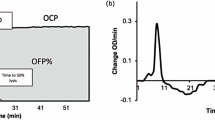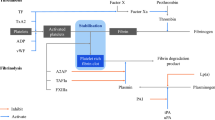Abstract
Venous thromboembolism represents a significant cause of Morbidity worldwide [1]. Korninger et al. [2] suggested that an impaired fibrinolytic response to venous occlusion May predispose to recurrent thrombosis. Various immunochemical and functional assays for the assessment of the components of the fibrinolytic pathway are available. The Main parameters determined are the tissue plasminogen activator (tPA), plasminogen and tissue plasminogen activator inhibitor I (PAI-1). Schulman et al. examined this hypothesis in a relatively large population [3]. He found that increased levels of tPA and PAI-1 correlated significantly with the development of recurrences, but concluded that the Measurements were of limited utility. A large cross-sectional study of venous thrombosis patients [4] came to a similar conclusion. In a recent study [5] the value of a comprehensive fibrinolytic screening in predicting recurrences was evaluated in 319 patients with a first episode of venous thrombosis. Assays were performed four weeks after the diagnosis of deep venous thrombosis while patients were receiving warfarin as well as one week after its discont inuation. No systematic differences in the levels of tPA antigen and functional PAl-1 or euglobulin lysis times were found between patients who did, or did not, suffer recurrent thrombosis. In a commentary to this article [6] Bauer comes to the conclusion that these classical fibrinolysis parameters are not useful in the assessment of the thrombophilia risk of patients with an initial episode of venous thrombosis.However the author also states that other mechanisms involved in the downregulation of fibrinolysis such as the thrombin activatable fibrinolysis inhibitor might be involved in the pathogenesis of thrombosis and that new assay systems of fibrinolysis might lead to an improved definition of the clinical implications of fibrinolysis abnormalities in patients with venous thrombosis.
Access this chapter
Tax calculation will be finalised at checkout
Purchases are for personal use only
Preview
Unable to display preview. Download preview PDF.
Similar content being viewed by others
References
Martinelli I. Risk factors in venous thromboembolism. Thromb Haemost. 2001 Jul;86(l): 395–403.
Korninger C, Lechner K, Niessner H, Gossinger H, Kundi M. IMpaired fibrinolytic capacity predisposes for recurrence of venous thrombosis. Thromb Haemost. 1984 Oct 31;52(2): 127–30.
Schulman S, Wiman B. The significance of hypofibrinolysis for the risk of recurrence of venous thromboembolism. Duration of Anticoagulation (DURAC) Trial Study Group. Thromb Haemost. 1996 Apr;75(4):607–ll.
Malm J, Laurell M, Nilsson IM, Dahlback B. Thromboembolic disease—critical evaluation of laboratory investigation. Thromb Haemost. 1992 Jul 6;68(1):7–13.
Crowther MA, Roberts J, Roberts R, Johnston M, Stevens P, Skingley P, Patrassi GM, Sartori MT, Hirsh J, Prandoni P, Weitz JI, Gent M, Ginsberg JS. Fibrinolytic variables in patients with recurrent venous thrombosis: a prospective cohort study. Thromb Haemost. 2001 Mar;85(3):390–4.
Bauer KA. Conventional fibrinolytic assays for the evaluation of patients with venous thrombosis: don’t bother. Thromb Haemost. 2001 Mar;85(3):377–8.
Holmes MB, Schneider DJ, Hayes MG, Sobel BE, Mann KG. Novel, bedside, tissue factordependent clotting assay permits improved assessment of combination antithrombotic and antiplatelet therapy. Circulation. 2000 Oct 24;102(17):2051–7.
Calatzis AN, Fritzsche P, Kling M et al: A new technique for fast and specific coagulation Monitoring. European Surgical Research 28:S1 (89), 1996.
Editor information
Editors and Affiliations
Rights and permissions
Copyright information
© 2003 Springer-Verlag Berlin Heidelberg
About this paper
Cite this paper
Werni, A., Calatzis, A., Schramm, W., Spannagl, M. (2003). Functional Assessment of fibrinolytic Resistance in whole Blood. In: Scharrer, I., Schramm, W. (eds) 32nd Hemophilia Symposium. Springer, Berlin, Heidelberg. https://doi.org/10.1007/978-3-642-18150-4_45
Download citation
DOI: https://doi.org/10.1007/978-3-642-18150-4_45
Publisher Name: Springer, Berlin, Heidelberg
Print ISBN: 978-3-540-43884-7
Online ISBN: 978-3-642-18150-4
eBook Packages: Springer Book Archive




